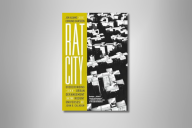You have /5 articles left.
Sign up for a free account or log in.
Thanks to an edition now available online from the University of Michigan Library, you can easily look up the word "Revolt" in the great Encyclopedia that Diderot and d'Alembert compiled in the 18th century as part of their challenge to the pre-Enlightenment order of things. A revolt is an "uprising of the people against the sovereign" resulting from (here the entry borrows from Fénelon) "the despair of mistreated people" and "the severity, the loftiness of kings."
That certainly counts as fair warning -- and indeed, the Encyclopedia then shifts into wonkish mode, advising any monarch who happened to be reading that he could best control his subjects "by making himself likable to them... by punishing the guilty, and by relieving the unhappy." Plus he should remember to fund education. Won't someone please, please think of the children? While Louis XVI was by no means a total dullard, it seems this advice was wasted on him. (See also "Regicide.")
Scores of other occasions when "the despair of mistreated people" collided with severe, lofty, and unlikable authority are covered in The International Encyclopedia of Revolution and Protest, 1500 to the Present, just published by Wiley-Blackwell. With seven volumes of text, plus one of index, it covers upheavals on every continent except Antarctica, which tends to be pretty quiet. A digital edition is also available.
The work of an international team, the Encyclopedia is edited by Immanuel Ness, a professor of political science at Brooklyn College of the City University of New York. I have been reading around in it (as is my wont) for the past few weeks, when not following the latest tweets of resistance from within Iran, and wanted to ask Ness a few questions about his project. He responded to them by email. A transcript of the exchange follows.
Q: The title of this reference work raises a question. Protests do sometimes lead to revolution, of course, but none that I've ever been to ever has. Although both activities involve departures from (and opposition to) the routines of a given society, revolution and protest seem to be rather distinct processes. Why bring them together like this?
A: Revolution and social transformation are ultimate goals of protests that have arisen from collective grievances when leaders of states and societies are unable or unwilling to come to terms with abject inequality or injustice. Undeniably not all protests lead to revolutionary change and most protesters will not live to see the results of their actions. But when successful, they are the culmination of waves of social grievances against authoritarianism, social and economic inequality and injustices frequently expressed over decades and even centuries.
In the project, we document when protests lead to revolution as well as demonstrations that are manifestations of systemic injustices, even if a revolution did not result immediately thereafter. Thus, the Bolshevik Revolution consolidated the mass peasant and worker movements that peaked in the early 20th century. By contrast, in the Philippines, the powerful peasant protest movements have failed to lead to a transformation of society. While the goal of creating a democratic and equitable society remains unfulfilled there, mass protests persist against injustice.
Despotic systems of rule can stave off resistance, but the history of the last 500 years demonstrates that revolutionary change is an ineluctable process.
Q: OK, but that assumes revolution and protest are means to the ends of justice and equality. I'm not sure the entries in the Encyclopedia all confirm that notion. There is one on fascism, for example: a movement that regarded itself as revolutionary, as the sociologist Michael Mann has emphasized. And come to think it, the "Tea Party" events in the United States earlier this year were protests, of a sort -- but for the most part they were just media stunts. How do you square this messy reality with what sounds like a base-line conception of revolution and protest as the midwives of progress?
A: In developing the work, we debated whether to include fascism and totalitarianism as social movements, and decided they were necessary to maintain a definitive unbiased understanding of the history of protests and revolutions. In many instances, demagogues across the political spectrum have used populist rhetoric and forces to defend violence and repression.
We were cognizant of the manipulative use of revolutionary rhetoric and symbols by repressive leaders to maintain and achieve power. But these entries also examine the popular discontent and resistance to injustice and oppression. For example, throughout Europe, we focused on the proliferation of partisan opposition to Francoism, Nazism, Fascism, and Stalinism. Similarly in the Global South, we documented popular opposition that emerged in response to dominant religious, ethnic, class, and oligarchic rulers that have relied on violence to repress the powerless.
As sociologist James Scott exposed in his work on guerrilla movements, we documented cases of armed resistance that often redounded against the most powerless that are often caught reluctantly in the crosshairs of conflicts. But, in researching modern history, while we may disparage the motivations of some reactionary movements that were cynically manipulated by leaders, the vast majority of social protest was engaged by ordinary people seeking justice, equality, and social inclusion.
Q: Your project is ambitious; it seems to cover the whole world. Is this a matter of some editorial orientation towards the new global or transnational history, or was it simply a matter of the various movements and uprisings seeming to be interconnected and to influence each other (as the cross-references tend to show)? And why does the period it covers start in 1500?
A: In crafting the project, from the outset, we were mindful of utilizing an approach rooted in world history, which seeks a broader examination of human civilization rather than the geographically parochial and theoretically circumscribed western civilization that I consider fairly indifferent to the majority of people who live throughout the world. Geographically, the project is framed from the perspective of world history, which appreciates the dominant processes of empire, migration, capitalism, environmental change, political, and social movements.
Using a world history frame, we found that many political movements are interconnected as arcs of resistance that appear through the processes of imperial expansion and resistance in various spheres of influence. For instance, Latin American resistance to Spanish colonial rule and then the post-colonial era can be viewed through arcs of resistance against European dominance, slavery, racism, and then indigenous struggles for civil and equal rights that appeared through the last 500 years though emerge more decisively in various historical moments. For instance, the numerous essays on indigenous movements reveal that resistance throughout the Americas is reaching a new apogee in the contemporary era.
The decision to begin with protests and revolutions at 1500 recognizes the important historical and social science research that identifies the beginning of the modern era with the dramatic expansion of European imperialism, emergent capitalism, and slavery that significantly emerged and rapidly expanded as major forces throughout the world. The temporal organization owes much to the path-breaking historical work of Fernand Braudel and the Annales School and Immanuel Wallerstein and subsequent World Systems Theorists.
Q: Any revolution is an interpretive minefield. Even nomenclature provokes arguments. (You can't refer to the Khmer Rouge in Cambodia or the Shining Path in Peru without somebody calling you a running dog lackey of the imperialist bourgeoisie for using those terms, since the respective organizations preferred to be called something else.) How did you strive with the need for balance and objectivity -- given that in some cases the very possibility of them is in dispute? Your introductory note for the Encyclopedia says that each article was examined by two members of the editorial board, and that more than half of the submitted pieces were rejected on various grounds. Did that mean you had to leave certain subjects out?
A: Realizing balance and objectivity in each entry was one of the greatest challenges in editing the work. In part this involved seeking to include editors with erudition in their respective fields who had a range of perspectives on the history of protest and revolution. While contributors were enthusiastic about this work, writers with similar perspectives did not necessarily agree with all the interpretations and conclusions. It reminds me of the Italian adage on the divisions on the left: “amici nemici parenti serpenti” (friends can be enemies but families are like a nest of vipers). Of course, the editors engaged in a respectful exchange of views, but people had different interpretations of the events and organizations. The encyclopedia includes arguments with a variance of opinion, but through the referee process, I ensured that the historical facts were correct, even if people reached different conclusions.
The history of the Cold War demonstrates that the US and Soviet Union supported various movements for the purpose of maintaining influence, even if those movements engaged in horrible acts of genocidal violence and brutality. We document each of these cases candidly even if the facts are jarring to one’s political affinities. The US supported the Khmer Rouge in Cambodia even after the party killed some 2 million civilians and was deposed through armed intervention by Soviet-supported communist Vietnam. Even if the narrative histories are disturbing to Maoist supporters of the Khmer Rouge and other groups, it is crucial that we document the horrific unfolding of events.
Still, in the case of Cambodia, while it is easy to blame the Khmer Rouge for all the violence, history demonstrates that for more than 100 years, European and then U.S, colonialists bear responsibility for destroying a culture and society. So, I think that it is crucial to understand the imperialist antecedents that set the stage for militant separatism as is the case of the Khmer and the Shining Path.
Through peer review we selected the most erudite essays submitted on similar topics. Our goal was to have each entry provide an entry point into a historical field of enquiry through providing extensive references. Even in an eight-volume work, our objective was achieving historical significance while remaining comprehensive. We are updating this work next year to include any essays that are worthy.
Q: The situation in Iran has taken a dramatic turn over the past month. Is this a new stage of the revolution that began in 1978-79? A repudiation of it? Something provoked by the CIA? Part of a larger wave of protests stimulated (directly or indirectly) by the global economy? A predictable consequence of so much of the population being young and full of rising expectations?
A: Well, as a rule, we avoided entries on recent events in the last five-to-ten years since the jury is still out and it is impossible at this point to gain more than a general sense of the social forces on the ground. Thus, while some recent events are included, the passage of time is essential to understand the forces at play. As such we excluded some of the “color revolutions” as it is too soon to discern the various groups engaged in the contestation for power. I have noticed that some in the West have already dubbed the Iranian protests as the “Green Velvet Revolution,” almost if it is part of a branding process.
It appears that some sort of democracy is in play today, irrespective of the forces manipulating the protests for their personal or factional benefit. In the Encyclopedia one can learn that the democracy movement in Iran is not a recent phenomenon but endures from the decisive electoral victory of Mohammad Mossadegh in 1953, which represented a repudiation of British interference in Iran, a theme in the unfolding of events today. But the CIA-supported Shah Mohammad Reza Pahlavi’s 1953 military putsch went on to annihilate all democratic opposition. With all democratic forces crushed by the Shah, the Shiite Islamic clerics gained currency in the wake of the Iranian Revolution of 1979, just as Napoleon consolidated power after the French Revolution. No less, the popular will for democracy, equality, and popular control remains a significant force in Iran as in nineteenth century France. I think that while foreign meddling may have occurred, last month’s elections also reveal that the vision of a democratic and egalitarian society remains unvanquished.








